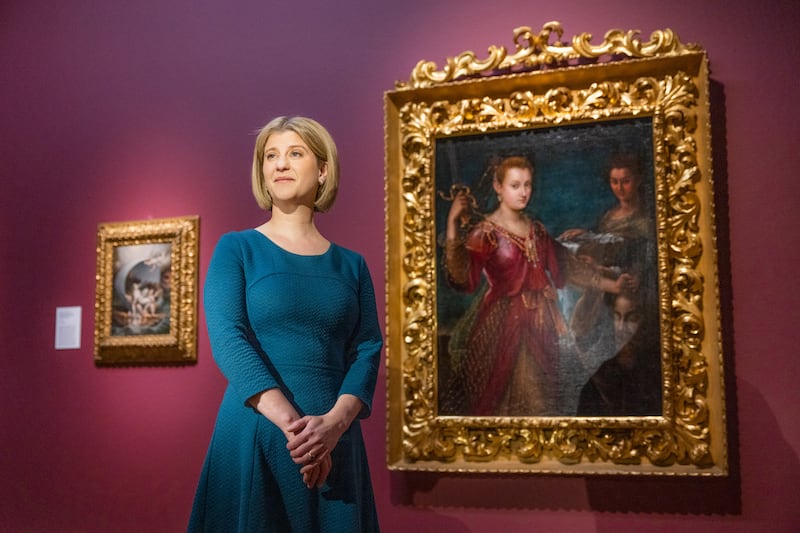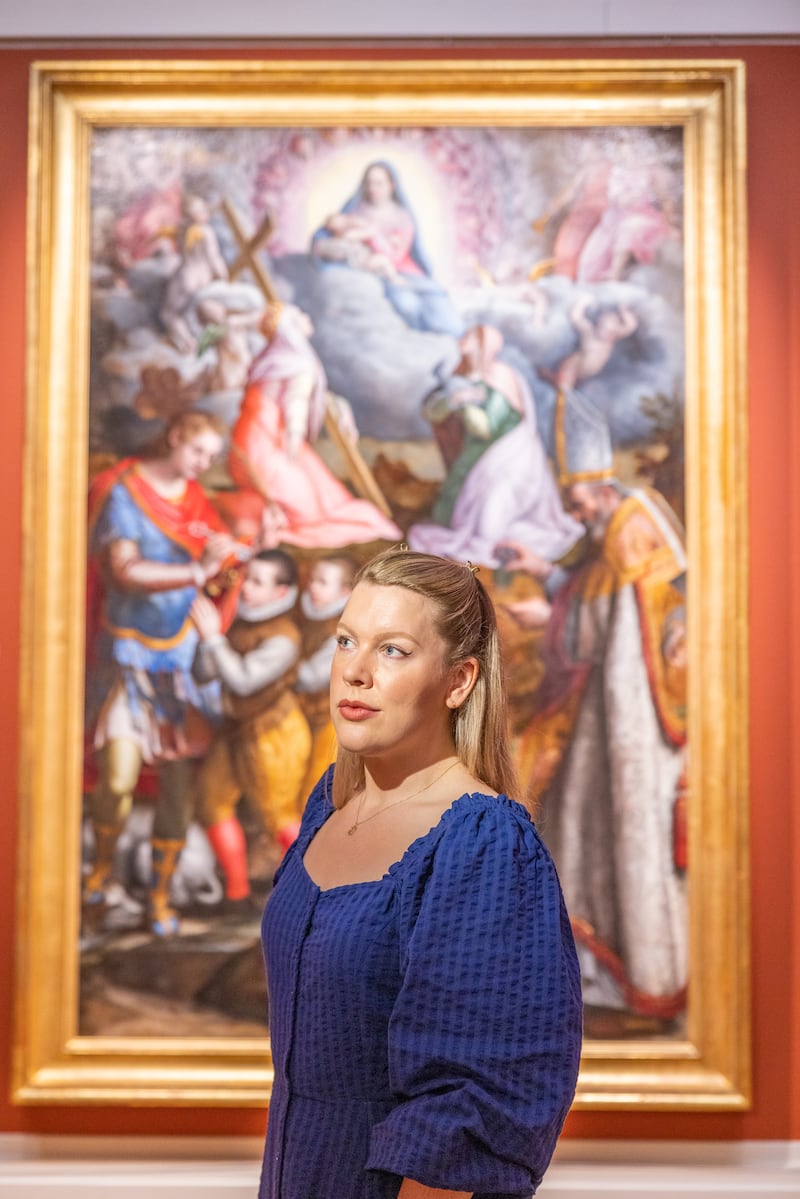“Happy families are all alike; every unhappy family is unhappy in its own way,” Tolstoy observed tartly at the beginning of his novel Anna Karenina. Certainly The Gozzadini Family, in Lavinia Fontana’s breathtaking, large-scale portrait, looks distinctly unhappy, in a way that took some figuring out on the part of historian Caroline Murphy. She traced a tangled web of family intrigue and bad faith skilfully incorporated into a painting once thoughtlessly dismissed as “an image of two insignificant noblewomen, devoid of soul, whose only desire is to display their rich clothes and jewels”.
It’s certainly true that the women are dramatically foregrounded in the painting, while the male figures skulk suspiciously in the shadows, occupying an altogether darker, gloomier register. And that is the point. Laudomia (on the right), commissioned the painting. She and the other woman, Ginerva, were the illegitimate daughters of the man between them, Ulisse. In a childless marriage, he set out to legitimate the girls and marry them off to distant cousins to perpetuate the family name. When Fontana made the painting, he and Ginerva were already dead, Laudomia’s husband had proved to be completely ineffectual and preoccupied with other things, while her brother-in-law was dishonest and venal, withholding vital money due to her.
Within the bounds of a conventional family portrait, she set out to indicate this underlying story and found the perfect artist in Fontana. Not surprisingly the two became close (Fontana later named one of her daughters Laudomia) and the work marked Fontana’s arrival as the portraitist of choice for Bolognese noblewomen. Laudomia, poised and determined, and her sister wear their elaborate wedding gowns, superbly detailed by Fontana. It is important to point out that her painting of fabrics, jewellery and decorative objects goes way beyond a dutiful recording of her subjects’ wealth and status – she clearly loves doing it – and is a continual delight in her work. Far from being mere props, these beautiful things, beautifully painted, are the very substance of her work.
She flourished in a Post-Tridentine aesthetic climate, significantly shaped by Cardinal Gabriele Paleotti, who mapped out a template for a clear, devout, accessible art and … up to a point, female participation
Equally, her attentiveness to faces, heads and hands is always richly rewarding – not to mention her liking for, and pictorial use of the miniature spaniels popular at the time. If not the largest, the portrait paintings are really the stars of the show, compelling and majestic. This is true particularly of the portraits of women, but also those of children, including the quite extraordinary Child in a Cradle. The portraits were of course commissions, but one feels there is more of Fontana in them than in several large religious commissions. The latter were essential – Bologna was ruled by the papacy in co-operation with a network of local families, and the church dominated much of social life – and she was certainly well able for them.
READ MORE
She flourished in a Post-Tridentine aesthetic climate, significantly shaped by Cardinal Gabriele Paleotti, who mapped out a template for a clear, devout, accessible art while actively encouraging patronage and, up to a point, female participation. Predictably, he warmed to what might be termed the sobriety of Fontana’s work. That work equally accords with the naturalism favoured by the local, influential artistic clan, the Carracci. But operating all the while within many constraints, Fontana managed to make a body of work that is reflective of her own strengths, interests and particular abilities.
All this and a great deal more comes across in the National Gallery of Ireland’s (NGI) benchmark exhibition Lavinia Fontana: Trailblazer, Rule Breaker, a dazzling, thoughtful survey show that should enhance her already stellar reputation as the first woman to be accepted as a professional artist in Europe. This at a time when women’s legal position was, in historian Frances Borzello’s words, “akin to that of minors, first in the care of their fathers, then of their husbands.”

NGI Director Caroline Campbell notes that, in the constraints of the system whereby women were largely confined to the home, widows had a greater degree of autonomy and played an important role in cultural life: look closely and that was clearly the case in Bologna, as women sought to exercise whatever agency they could. Bologna was, vitally, a thriving university town with, unusually, a large female student contingent and a vibrant community of female intellectuals.
As with several other women who did become artists, Fontana was the daughter of an artist, Prospero (her mother was from a prominent publishing family), and while girls were not allowed to become apprentices to artists, nor draw from the live model, the essential means of training, they could manage to acquire the requisite experience under the radar, so to speak, in family workshops. As it happens, Fontana came quite late to her calling and was 23 when she painted her first surviving, signed work. It seems likely that her father, his own earning capacity diminishing, recognised her potential and saw she would be capable of running the studio, which she certainly was. He arranged a prospective husband, an artist by all accounts greatly inferior to Fontana, but usefully capable of handling the public side of the business. Incredibly, while pursuing her career, she had 11 children, of whom only three outlived her, at a time when pregnancy and birth were fraught with risk. This means she was, as Dr Campbell points out, pregnant for much of her working life, even as the responsibilities of running a household and workshop weighed on her shoulders.
By historical chance, the National Gallery of Ireland has long been home to one of Fontana’s finest extant paintings and the largest, The visit of the Queen of Sheba to King Solomon. It’s a fantastic, visually striking allegory in which Solomon and Sheba are attended by a frieze-like row of, surely, Bolognese noblewomen, fabulously attired. Mystery surrounds its early history following its completion in 1599, and subsequently, it had a bumpy, abrasive ride via 19th-century France to Christie’s in London, where it was purchased by Ireland’s fledgling national gallery in 1872. Its importance was always recognised, but study of the work gained pace this century, not least because of Fontana’s exceptional status.

The NGI’s curator of Italian and Spanish art, Aoife Brady, was involved in the headline restoration project on the painting from 2019, and the experience sparked in her the idea of staging the current, comprehensive Fontana show. Her research also led her to a proposed revision of the historical presumption, dating from a 1778 inventory, that the models for the characters of Solomon and Sheba were the Duke and Duchess of Mantua.
Over the years, even late in the 20th century, a degree of confirmation bias has attended this theory, so that researchers seemed to look for supporting rather than contradictory evidence. Brady’s proposition, now gaining wide acceptance, is that the couple were in fact the Duke and Duchess of Ferrara, Alfonso II d’Este and his wife Margherita Gonzaga. Without going into great detail, it’s fair to say that part of the beauty of Brady’s proposition is that it convincingly accounts for certain puzzles surrounding the painting’s protracted making, and its absence from several expected historical records.
Another painting, incidentally, Judith with the Head of Holofernes, was substantially transformed by cleaning in preparation for the show, revealing an unsuspected lightness, depth and richness of colour. Fontana moved her family to Rome about 1603 or 1604, at the invitation of Cardinal Bernerio, to become a portraitist at the Vatican Palace. Professionally she thrived and was very highly regarded there. But almost immediately her daughter Laudomia died, aged only 14. Artistically gifted, Laudomia had seemed the most likely of the children to follow her mother as an artist. Fontana never got over losing her. Cruelly, she also had a problem with her hands, perhaps arthritis, that caused her pain and difficulty.
This meticulously considered show draws together Fontana’s key works not just from her home city, Bologna, but also from other locations in Europe and the US
Minerva Dressing, a rare female nude, is her last known work. A commission from, incongruously, a cardinal, Camillo Borghese, later a pope, it depicts the goddess of peace, war, wisdom and the arts about to don a robe, her familiar attributes – armour, an owl, an olive tree glimpsed through the window – distributed throughout the composition. Strangely haunting, it is quite a low-key work, but it has invited much speculation because the figure of Minerva, viewed from the side looking back over her shoulder (her head closely recalling Venus in Fontana’s notably profane earlier painting Venus and Mars), is naturalistically observed, suggesting a grasp of overall anatomy not usually apparent in Fontana’s work.
Had she broken the rules and drawn from a nude figure? In one way or another, it would seem so. This meticulously considered show draws together Fontana’s key works not just from her home city, Bologna, but also from other locations in Europe and the US. It incorporates original documents and objects – including a contemporary German table clock, a gilded marten’s head and fabric samples. While it more than makes the case for a reassessment of Fontana the artist, it is also vastly enlightening about the daunting challenges she and other women faced at the time, and the stamina, resourcefulness and ingenuity required to meet them. It is, simply, unmissable.
Lavinia Fontana: Trailblazer, Rule Breaker, curated by Aoife Brady, is in the Beit Wing at the National Gallery of Ireland, Merrion Square West and Clare Street, Dublin, until August 27th. Booking and entry fees, with concessions, apply. See nationagallery.ie















